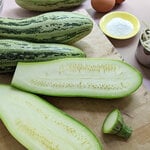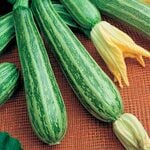Growing Squash and Melons
While Yellow Squash, Zucchini, Cantaloupe, Watermelons, and Pumpkins have distinct flavors and unique appearances, they—along with over 900 other species—are all members of the Cucurbitaceae plant family. Cucurbits are vining plants that produce “Pepos”—bulky fruits with plentiful seeds and tough rinds. They produce abundant yields through summer and early fall, and the flavors of succulent Cantaloupe, piquant Zucchini, and savory Summer Squash are often synonymous with the season.
Despite their culinary differences, most varieties of Squash and Melons have similar growing and care requirements. Whether you want to grow a single Zucchini plant in a pot or sow a field of Cantaloupe, follow these instructions to grow bountiful Cucurbits.
Planting Melons and Squash
When to Plant
Native to warm regions, Melons and Squash are highly sensitive to cold temperatures. Providing a long, hot growing season will help increase the quantity and quality of the fruits they produce. Start seeds indoors 2–3 weeks before the last frost to help extend the growing season, or plant them outdoors at least 2 weeks after the last frost when the soil reaches 70°F. Purchasing an established plant can help extend the growing season, especially in cooler parts of the country.
Site Selection
Choose a planting location in full sun with rich, fertile soil and good drainage. To reduce soil-borne diseases, do not plant Squash, Pumpkins, Watermelon, and Cantaloupe in the same location for 2 or more consecutive years. After 3 years of rotating crops, it is generally safe to plant Cucurbits in a prior grow site again.
Soil
Squash and Melons grow best in loose soil that is slightly acidic, with a pH of 6.0–7.0 (check the requirements for your specific genus/plant). If growing your plants directly in the ground, test the soil and amend it as necessary to achieve the proper pH, incorporating ample compost to fuel fruit production. If growing them in a container or raised garden bed, purchase a high-quality growing mix formulated for vegetables, and ensure the plants have adequate drainage.
Spacing
When planting established seedlings, follow spacing instructions provided by the nursery. Allow at least 5–6’ between rows to facilitate easy access for weeding and harvesting.
Light
Members of the Cucurbitaceae plant family require full sun. Plant Squash, Melons, and Pumpkins in a location where they receive 8–10 hours of direct sunlight each day.
Growing Vertically
Opt for vining varieties of Squash and Melons where space is limited or pests are a problem. These varieties can be trained to grow vertically on arbors, trellises, or pergolas. Establish a freestanding support structure or secure the trellis against a south-facing wall or fence to ensure the plants receive ample sunlight. When growing vertically, plants should still be set 24–48” apart, but you can utilize extra space around the stems to grow other plants, effectively doubling your usable growing area.
As the plants begin to grow, attach them to the supports using soft string or ties or by weaving the stem through the grates. The plants will produce tendrils that help grip the supports for added stability. During the heat of the summer, plants grow quickly, so check them every few days to help train new vines upward.
Smaller fruits—such as Summer Squash and Zucchini—can hang freely from the vines without issue, while larger fruits—such as Cantaloupe and Winter Squash—require additional support as they grow. To provide support, tie a piece of cloth, netting, or nylon stockings around the bottom of the fruit, leaving enough slack for the fruit to grow, and attach it to the trellis, arbor, or pergola.
Growing Squash and Melons in Containers
With proper care, select varieties of Squash and Melons can be cultivated in containers to provide abundant yields of fruit. Bush varieties of Squash, Zucchini, Cantaloupe, or Pumpkin are ideal for containers as they require less space than their vining relatives.
Choose your pots wisely, being careful not to overcrowd the plants. One plant can easily fill a 24” pot, so plan to use a larger container or multiple containers if you want to grow more than one plant. Drainage is extremely important, so ensure each container has sufficient holes in the bottom.
Use a high-quality soil formulated for growing vegetables in containers. This type of soil will have the appropriate pH and will drain adequately to keep plants healthy and fruitful. For best results, mix ⅔ soil and ⅓ compost. Add a layer of mulch to help the plants retain moisture.
Place each container in a location where it will receive at least 8 hours of direct sunlight each day and water thoroughly whenever the top 1” of soil feels dry to the touch. Side-dress with compost or 5-10-10 fertilizer when the plants are about 6” tall and again when they start to bloom.
As your Squash and Melons grow and produce fruit, even bush varieties may benefit from a small trellis to help support the weight of the fruit. Use soft twine or ties to loosely tie vines to the trellis as needed.
Melon and Squash Care
Watering
If rain is scarce, water Squash, Zucchini, Cantaloupe, and other Cucurbits deeply, delivering about 1–2” of water at a time. Water at least once per week, and more frequently as temperatures increase in the heat of the summer. Try to avoid overhead watering or using sprinklers as the plants mature. The goal is to water the soil and not the plants’ leaves. This not only saves water, but reduces the risk of disease, especially in humid weather. Watering wands are useful to reach under leaves and directly around the root zone. Apply a thin layer of mulch to help keep plants evenly moist and free from weeds.
Fertilizing
Side-dress with compost or 5-10-10 fertilizer when the plants are about 6” tall and again when they start to bloom.
Harvesting
On average, Cucurbits require between 50 and 100 days to reach maturity and produce ripe fruit. As fruits begin to form on the plants, thin them to two fruits per vine for healthier growth.
- Harvest Summer Squash and Zucchini while they are still small (6–8" long) and tender by cutting the fruit from the plants.
- Harvest Cantaloupe by gently tugging on the fruits. They are ready to harvest when they easily break away from the vines.
- Harvest Watermelon by pulling the fruit from the vine when the tendrils on the stem near the melon are brown and dry.
- Harvest Winter Squash and Pumpkins before the first frost. Cut the fruit from the vine, leaving 4–5" of stem attached (as long as the stem is at least 1”) so the pumpkin can both cure and be stored properly. Cure in a warm, well-ventilated location for 7–14 days. Both can be cured outside—in the sun is best—if there’s no chance of frost and the weather is dry. Then cook or store them at 50-70°F out of direct sunlight.
Pests and Diseases
Squash, Zucchini, Cantaloupe, Watermelons, and Pumpkins fall victim to the same pests and diseases. To reduce the risk of infestation and infection, do not grow members of this family in the same location year after year. Common pests and diseases for Cucurbits include:
- Squash Vine Borer – These pests, prevalent along the East Coast of the US, are the larvae of a native orange and black seslid moth. This is a Clearwing moth that is active during the daytime and is often mistaken for a wasp. The moths lay eggs around the base of Squash and Pumpkin plants, which hatch and then feed on the vines. Multiple borers feeding on a stem can rot and kill the entire plant.
To thwart these moths, try the following:- Flick resting moths into a container of soapy water at dawn or dusk when they are inactive, resting on plants.
- Set out a yellow water trap—a yellow bucket or other container of water—the moths are attracted to the color and drown in the water (source: UCONN)
- Beneficial nematodes can be purchased and applied to the soil around the plants.
- Leaves and vines can be treated with garlic spray.
- Set Pheromone traps to monitor their presence.
- Set yellow sticky traps
- Plant Hubbard squash (which they prefer) early—before planting other squash—to act as a trap crop (moths will lay eggs on these plants, which will then be destroyed).
- In the North, plant squash in late July, once the life cycle of this insect is over. (Moths hatch, emerge from the soil, and lay eggs in late June/early July. Each moth can lay 150 eggs in a season; eggs hatch into larvae/caterpillars in 9–11 days.) In the South, there may be two generations, so the active life cycle time is May—mid-August.
- Cover plants with floating row covers until they have 2–3 sets of true leaves or begin blooming. Then remove the cover so pollinators can get to flowers, and wrap a 2” wide band of aluminum foil around the stem, tucking it into the soil to thwart egg-laying. Periodically re-wrap as the vine grows, to avoid girdling the vine.
- Plant pest-resistant varieties (Butternut and other winter squash varieties, along with Pumpkins and Cucumbers).
- Do not plant Cucurbit family plants in the same spot the next year.
- Remove and destroy all the plants at the end of the season. Do not compost. Till the area in the fall to destroy overwintering cocoons.
- Squash in community gardens are particularly susceptible unless everyone takes measures to discourage these pests.
If you notice early signs (collapsed leaves) of a Squash vine borer in a section of the plant, quickly cut it away from the rest of the plant to prevent the pests from spreading. Make a small slit (2” or so) from the entry hole up the vine, with a sharp utility knife, just above the hole. Gently pry the vine open and pick out the borer(s); make the slit longer if necessary, and gently run a thin wire up inside the vine to pierce any remaining borers. Then cover the base of the vine with compost-enriched soil to encourage the plant to form new roots.
- Powdery Mildew – this fungus coats leaves and stems, causing them to shrivel and die. It spreads quickly and can stay in the soil over winter, so it is especially important to rotate crops each year to help prevent infestation. Remove and discard plant debris at the end of the growing season; do not compost infected plant material.
Keep leaves dry by watering the plants via ground-level irrigation whenever possible. If mildew appears, treat it immediately to prevent spreading. Remove any affected plant material and treat the remaining plants with an organic fungal spray, such as sulfur oil, neem oil, or a fixed copper fungicide, until the infection clears. Always check product labels as some of the products should only be used when bees are not active.
Frequently Asked Questions
Can I grow Melons and Squash together?
Due to their similar growing styles and preferences, Melons and Squash are ideal companion plants. But because they are susceptible to the same pests and diseases, carefully survey your plants for issues and treat them immediately before infections and infestations spread. Rotate crops regularly and avoid planting any members of the Cucurbitae family in the same location for two consecutive years.
Despite Melons and Squash belonging to the same family, they cannot cross-pollinate one another. Rest assured you will not accidentally create a pumpkin-watermelon hybrid in your vegetable patch. There is a minor risk of cross-pollination when growing members of the same species together—for instance, two types of Butternut Squash—so if you save seeds, you may want to separate your plants or grow a single species at a time.
How long do Melons and Squash take to grow?
Most Squash and Melons take 2–3 months from sowing before you can begin harvesting ripe fruit. Exact maturation times vary by species and variety, with common ranges as follows:
- Summer Squashes: 50–65 days
- Cantaloupe: 70–140 days
- Watermelons: 75–100 days
- Winter Squashes: 80–100 days
- Pumpkins: 90–120 days
When is the best time to plant Squash and Melons?
These fragile crops cannot tolerate frost. Plant them outdoors a few weeks after the last frost has passed—depending on your USDA Hardiness Zone, this is generally from March to May. To extend the growing season, start seeds indoors a few weeks before the last frost date or buy established plants from a reputable nursery to plant immediately.
What are the growing stages of Squash and Melons?
Within a few weeks of sowing, seeds will germinate and produce small green shoots. These shoots will develop large vines or bushes, producing flowers after about 1–2 months. The flowers give way to fruit, which may take a few weeks to ripen, depending on the variety.
Squash and Melons We Offer:





